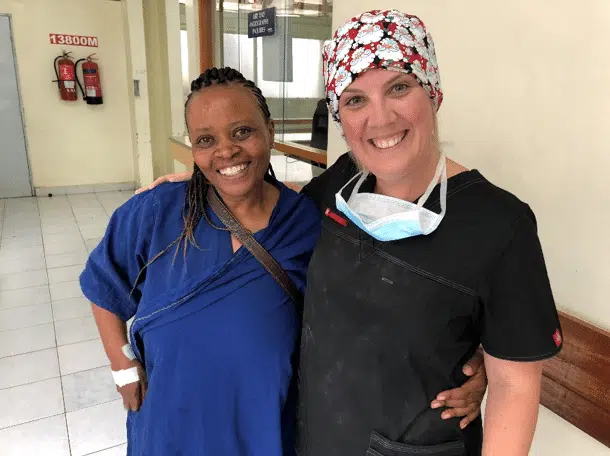It’s well documented in medical literature that women of African descent develop uterine fibroids five to six years earlier and are more than 5 times as likely to have severe symptoms than Caucasian women of a similar family history.1
With the increasing number of women requiring fibroid treatment, hospitals in Kenya have welcomed international doctors to treat their patients with uterine fibroid embolization (UFE).
In July 2018, Dr. Darren Klass, interventional radiologist with Vancouver Coastal Health in Vancouver, British Columbia, Canada, traveled to Kenya with Merit Medical Systems Inc.—sponsor of Ask4UFE—to educate Kenyan gynecologists and radiologists on this uterine-sparing, minimally invasive option. By providing one-on-one UFE training to gynecologists—the doctors responsible for referring patients to radiologists for treatment—they can start recommending and providing this option to their patients.
In an intensive 10 days, Dr. Klass hosted a number of UFE training courses to several clinical teams in Karen and Kenyatta National Hospital in Nairobi and Aga Khan in Mombasa. Patients were also scheduled to undergo UFE in both cities. To help make this treatment possible, Merit Medical donated a portion of the embolic particles used for UFE procedures, called Embosphere® Microspheres. Dr. Klass observed and trained the clinical teams while they treated their own patients.
Traditionally, UFE has been performed through the femoral artery in the groin area. However, UFE can now be done via the radial artery in the wrist—a technique known as transradial access. This approach proved to be an eye-opener to both the Kenyan interventional radiologists and their clinical teams. Doctors observed how their patients were able to move and walk immediately post UFE and how patients could make themselves comfortable without having to lay still on their backs, which is required with femoral UFE.
All of the clinical skills taught and the education provided proved especially useful on the eve of the final day in Mombasa. Following a long day of training, Dr. Klass was called by a gynecologist to discuss an emergency case. A bedside consultation was done together with the referring gynecologist at around 8pm. The patient underwent a successful UFE procedure the following day and was discharged 24 hours post UFE. In this particular case, due to extenuating patient circumstances, UFE provided not only a uterine-sparing therapy for symptomatic fibroids but also a life-saving option. This experience was more than enough to show referring gynecologists that UFE is an effective fibroid treatment option. The gynecologist presented the case to an audience of doctors at a weekly Kenyan Medical Association meeting the night following the procedure.
The skills learned by the Kenyan radiologists can have a far-reaching impact, even beyond UFE. Because of the training with Dr. Klass, radiologists in both Mombasa and Nairobi can now also perform embolization for post-partum hemorrhage. Statistics show that 6,300 women die in Kenya each year during pregnancy and childbirth.2 A 2015 Kenyan policy document reported the maternal mortality rate at over 2,000 per 100,000 live births in North Eastern Kenya, and 212 per 100,000 live births in Nairobi, with hemorrhage accounting for 44% of those deaths.2
“Post-partum hemorrhage is an avoidable complication of childbirth and providing the radiologists here with the ability to treat this devastating complication with an effective therapy will hopefully have a dramatic impact on this shocking statistic,” Dr. Klass explains.
The time spent in Kenya was brief, but the main objective was achieved. Kenyan doctors can now provide these essential services to women.
“I arrived here wanting to improve the lives and care of women in Kenya,” Dr. Klass tells Ask4UFE. “I am pleased that by training radiologists in Kenya to perform this life-changing procedure, I saw this happening. Every single person I met in Kenya was grateful for the purpose of this trip.”
REFERENCES
1. Huyck, K. L., Panhuysen, C. I., Cuenco, K. T., et al. (2008). The impact of race as a risk factor for symptom severity and age at diagnosis of uterine leiomyoma among affected sisters. Am J Obstet Gynecol, Feb;198(2):168.e1-9.
2. National Council for Population and Development. (2015, Jun). Reducing Maternal Deaths in Kenya (Policy Brief No. 46). Retrieved from http://www.ncpd.go.ke/wp-content/uploads/2016/11/Policy-Brief-46-Maternal-Deaths-in-Kenya-1.pdf.









